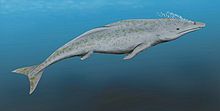
Protocetus
Encyclopedia
Protocetus atavus is an extinct species of primitive cetacean from Egypt
. It lived during the middle Eocene
period 45 million years ago.
 Protocetus had a streamlined, whale-like body around 2.5 metres (8.2 ft) long, but was relatively primitive in many respects; it still had small hind flippers, and its front flippers had webbed toes. Its jaws were long and lined with deadly teeth. The shape of the bones in the tails suggests that it may have evolved tail flukes, like those of modern whales, and, while it did not have a true blowhole
Protocetus had a streamlined, whale-like body around 2.5 metres (8.2 ft) long, but was relatively primitive in many respects; it still had small hind flippers, and its front flippers had webbed toes. Its jaws were long and lined with deadly teeth. The shape of the bones in the tails suggests that it may have evolved tail flukes, like those of modern whales, and, while it did not have a true blowhole
, the nostrils had already begun to move backwards on the head.
Unlike its more primitive predecessor Pakicetus
, the structure of the ears suggests that Protocetus was able to hear properly underwater, although it is unlikely that it could echolocate
. Similarly, it retained sufficient olfactory apparatus to have a good sense of smell
, although it probably relied more on its eyesight to find prey.
Egypt
Egypt , officially the Arab Republic of Egypt, Arabic: , is a country mainly in North Africa, with the Sinai Peninsula forming a land bridge in Southwest Asia. Egypt is thus a transcontinental country, and a major power in Africa, the Mediterranean Basin, the Middle East and the Muslim world...
. It lived during the middle Eocene
Eocene
The Eocene Epoch, lasting from about 56 to 34 million years ago , is a major division of the geologic timescale and the second epoch of the Paleogene Period in the Cenozoic Era. The Eocene spans the time from the end of the Palaeocene Epoch to the beginning of the Oligocene Epoch. The start of the...
period 45 million years ago.

Blowhole
Blowhole may refer to:*Blowhole , the hole at the top of a whale's or other cetacean's head*Blowhole , a hole at the inland end of a sea cave*Blowhole Diversion Tunnel in Victoria, Australia...
, the nostrils had already begun to move backwards on the head.
Unlike its more primitive predecessor Pakicetus
Pakicetus
Pakicetus is a genus of extinct terrestrial carnivorous mammal of the family Pakicetidae which was endemic to Pakistan from the Eocene .Pakicetus existed for approximately...
, the structure of the ears suggests that Protocetus was able to hear properly underwater, although it is unlikely that it could echolocate
Animal echolocation
Echolocation, also called biosonar, is the biological sonar used by several kinds of animals.Echolocating animals emit calls out to the environment and listen to the echoes of those calls that return from various objects near them. They use these echoes to locate and identify the objects...
. Similarly, it retained sufficient olfactory apparatus to have a good sense of smell
Olfaction
Olfaction is the sense of smell. This sense is mediated by specialized sensory cells of the nasal cavity of vertebrates, and, by analogy, sensory cells of the antennae of invertebrates...
, although it probably relied more on its eyesight to find prey.

